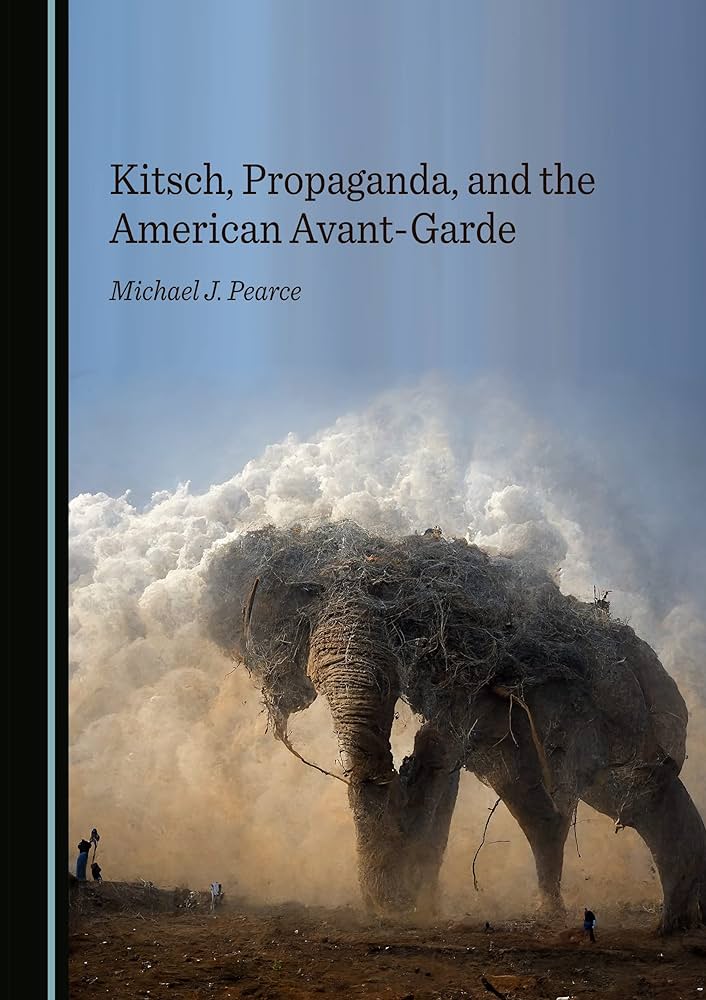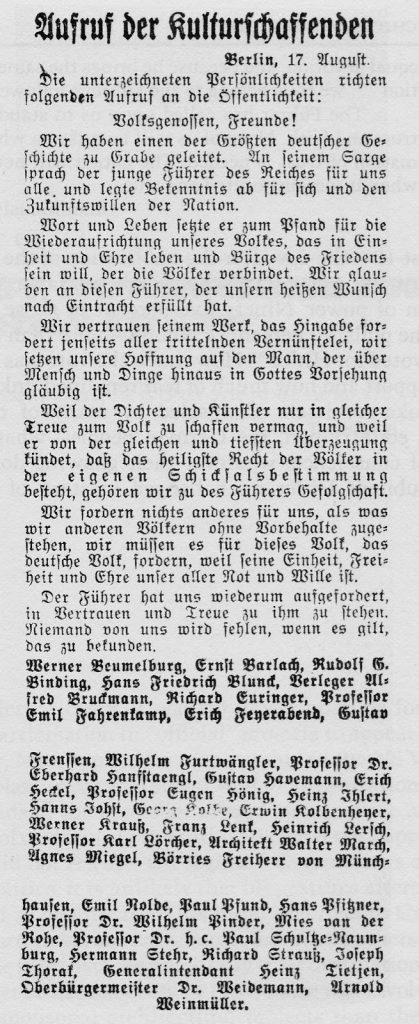
by James Stevens Curl
“Kitsch” means rubbishy pretentious trash — anything that is shoddy, tawdry, mawkishly sentimental and in bad taste. When applied to any of the arts, it suggests false, superficial, spurious imitation of real artistic creations. It implies that Kitsch art apes something without any real understanding or depth whilst at the same time trying to please, soothe and reassure. It has also been described as the cultural revenge of the proletariat, identified as an aspect of “camp” taste that values the outrageously hideous for its own sake. I have a certain sympathy for the latter view, which strikes me as rather more accurate.
In this important book, Michael J. Pearce, who is Professor of Art at California Lutheran University, dissects the weaponising of art as propaganda. He ranges from its extremely violent origins in revolutionary France, to the extraordinary adoption of supposedly avant-garde art by the United States of America to counter the totalitarian powers of National Socialist Germany and the Stalinist Soviet Union.
Any clear-sighted person who studies the pictorial propaganda produced under the ægis of the Nazis (posters, film, sculpture, postage-stamps, etc.) must concede that it was remarkably effective. It was drawing on traditionalist art linked to nature, the family and the homeland, but rejecting so-called “Modern Art”, which the NSDAP associated with large cities, internationalism and decadence. In painting, the “new realistic tendency” rendered every detail with exactness. It celebrated ordinary people, often farming families in domestic settings: harvesting, ploughing, peasant women wearing regional costumes in church. It also featured idealised female beauty, as in the oils of the “Master of the Curly Pubic Hair”, Adolf Ziegler (1892–1959). Ivo Saliger (1894–1987) was equally expert in that popular field, and there was plenty of heroic stuff idealising soldiers, sailors, airmen and, of course, Nazi Party activists, such as those uniformed members of the Sturmabteilung.
In 1937 two big exhibitions were held in Munich. One was concerned with “degenerate Art”. It featured expressionist, abstract, cubist, surrealist, etc. work, so that the public could compare it with the finely crafted representational paintings on show at the Great German Art Exhibition in the newly erected House of German Art, designed by Paul Ludwig Troost (1879–1934). In 1934 Professor Hans Adolf Bühler (1877–1951, no mean painter himself) criticised the “art” promoted by academies and museums, because it was above the heads of lay people, who did not understand it or like it. It was art for a select few — the art “intellectual and the art market”. To judge from the huge numbers of reproductions of Nazi-approved art purchased by the public, he had a point.
Powerful imagery was also employed in the Soviet Union to promote ideology, to celebrate the Party and Stalin, and in fact function as propaganda. Again, it was representational, often heroic, and it made an impact on ordinary people, who did not need to have obscure abstractions explained to them. What became known as “social realism” was common to both totalitarian states. In architecture, too, a stripped, elemental classicism was used to inform civic and official architecture. Meanwhile factories and other utilitarian structures were made of mass-produced components. They were to all intents and purposes “modernist”, devoid of any traditional architectural styling.
Curiously, in the democracies things were not that different. A stripped Classicism was also apparent in civic and official buildings, whilst factories, etc., were utilitarian “modernist”. What happened to turn everything on its head?
In 1939 the Nazi-Soviet Pact and the dismemberment of Poland caused more than a few flutterings in the artistic dovecotes. Up to then, officially sponsored social realist murals in American official buildings were (in terms of content and compositional-representational techniques) not all that different from similar works carried out under totalitarian régimes. Something had to give.
There were attempts to promote the idea of a true American art not indebted to Europe. Spurious links between the art of Native Americans and the crude art of untutored American primitivism were artificially manufactured. I have seen wonderful exhibitions of Native American design in Dumbarton Oaks, and I can state categorically that any alleged connections between that and American limners entirely indebted to the Western traditions are complete fantasy. It is a fake connection for which gurus like Alfred Hamilton Barr (1902–81) and the functionaries of the Museum of Modern Art in New York can be held responsible. Unsurprisingly, Native Americans had no interest in imitating Western art. Before the invasion of the colonising and murderous Europeans, indigenous decorative arts were untouched by the traditions of Europe. The people who created them had no wish to participate in any supposed cultural narratives of the West. Attempts by Barr & Co. to co-opt Native American art in the advancement of their flimsy ideology were at worst cultural appropriation, at best self-righteous condescension.
The dismemberment of Poland led to a curious state of affairs in the USA. The American avant-garde had already levered Germans such as Walter Gropius (1883–1969) and Ludwig Miës van der Rohe (1886–1969) into positions where they could impose modernist tyranny on American architectural education (part of a process Sibyl Moholy-Nagy [1903–71] perceptively dubbed “Hitler’s Revenge”). Now it began to oppose Nazi and Soviet representational art, casting it as the Kitsch art of the Enemy, so “individualist” abstract modern art was set up as spuriously symbolic of Western “democratic” freedom.
In 1939 President Roosevelt publicly endorsed the Museum of Modern Art. Very soon that institution became the temple and arbiter of modernism, the new artistic religion of the USA. It held that representational art was the enemy of the new, true, democratic, honest, fresh, exciting, fashionable, really American avant-garde. Something similar happened with the modern movement in architecture. Nikolaus Pevsner (1902–83), in his ominously titled and pernicious 1936 book Pioneers of the Modern Movement from William Morris to Walter Gropius, had hailed modern architecture approvingly as “totalitarian” because it was a “genuine style as opposed to a passing fashion”. It was now to destroy the great Beaux-Arts trajectory that had been the glory of American architecture. Pevsner naturally attempted to give modernism respectable antecedents by claiming that Arts-and-Crafts architects and artists were “pioneers” of the Modern Movement, just as MoMA endeavoured to invent connections with aspects of an American past. In fact Modernism both claimed and was a complete severance and brutal rupture with everything that had gone before, a ditching of millennia of development, trial and error, culture, the lot.
Roosevelt placed American culture in the hands of the Museum of Modern Art and officially endorsed Modernism, stating his intention to have it disseminated throughout the nation. He also claimed that American artists would be free, but in fact they were free only so long as they were true to the agenda of the Museum of Modern Art. Avant-garde had been embraced by a small coterie of the rich élite. Roosevelt seems to have endorsed it in public out of political expediency, but the resulting art policy made avant-garde a tool of the establishment, in service to the state, just as Nazi idealism served Germany, and Stalin-approved Socialist Realism served the USSR.

Pearce has researched his sources very thoroughly, but he makes some very curious errors. He gets the successor of the Marxist Hannes Meyer (1889–1954) as Director of the Dessau Bauhaus wrong: Meyer was actually followed by Miës van der Rohe, who eventually moved that establishment to Berlin-Steglitz in 1932. It was he, rather than Hitler, who closed it down as part of his attempts to ingratiate himself with the new government of Germany. In 1934 Miës van der Rohe had added his signature to a proclamation by German cultural leaders urging voters to support Hitler. It was published in the Nazi newspaper Völkischer Beobachter on 18 August; the following day Hitler was given absolute control of the Third Reich. All that was swept under the carpet by Modernist apologists. Tradition and classicism began to be falsely associated with Naziism, whilst the totalitarianism of modernism and the Nazi affiliations of people like Miës van der Rohe were conveniently hidden. Truth was inverted, and a vast, shoddy construct of bogus “history” was created.
The index is infuriatingly inadequate, but the most problematic aspect of this book is that when discussing art and specific exemplars, there should be illustrations for purposes of information and clarity. There is not one illustration in this tome. That is a very serious omission, one that is not only puzzling, but hard to forgive.
Nevertheless, this volume contains much that is both true and disturbing. It should be read by everyone as a corrective to the downright lies that have been spread about the supposedly “democratic” nature of Modernism. As Pevsner very clearly stated, whilst approving of it, the essence of modernism was totalitarian. It still is just that.
When governments use acolytes of the self-appointed avant-garde as willing tools of the state, we should all be afraid — very, very afraid, too. That is the elephant in the avant-garde landscape, to which the author of this erudite book refers.
First published in The Critic.
- Like
- Digg
- Del
- Tumblr
- VKontakte
- Buffer
- Love This
- Odnoklassniki
- Meneame
- Blogger
- Amazon
- Yahoo Mail
- Gmail
- AOL
- Newsvine
- HackerNews
- Evernote
- MySpace
- Mail.ru
- Viadeo
- Line
- Comments
- Yummly
- SMS
- Viber
- Telegram
- Subscribe
- Skype
- Facebook Messenger
- Kakao
- LiveJournal
- Yammer
- Edgar
- Fintel
- Mix
- Instapaper
- Copy Link






